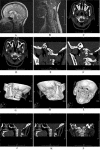Recurrent attacks of headache and neck pain caused by congenital aplasia of the posterior arch of atlas in an adult
- PMID: 22791780
- PMCID: PMC3029836
- DOI: 10.1136/bcr.05.2010.3053
Recurrent attacks of headache and neck pain caused by congenital aplasia of the posterior arch of atlas in an adult
Abstract
A 47-year-old Chinese woman, with a history of recurrent attacks of vertigo and vomiting for the past 5 years, presented with intermittent radicular pain in the left upper limb for the past 2 years. She also reported recurrent attacks of severe headache and neck pain for more than 10 years. The pain might be aggravated by coughing or sneezing and relieved after sleeping in the decubitus position. The MRI depicted Chiari malformation. A multidetector CT scan and three-dimensional CT reconstruction revealed partial aplasia of the left posterior arch of atlas of a small gap. The patient underwent plastic surgeries in Beijing. The disappearance of the recurrent pain syndrome was confirmed by follow-up after surgery.
Conflict of interest statement
Figures


Similar articles
-
A Man With Headache, Fever, and Neck Stiffness.JAMA. 2019 Apr 23;321(16):1624-1625. doi: 10.1001/jama.2019.1772. JAMA. 2019. PMID: 30924841 No abstract available.
-
Bipartite atlas with os odontoideum: case report.Spine (Phila Pa 1976). 2004 Jan 15;29(2):E35-8. doi: 10.1097/01.BRS.0000106487.89648.88. Spine (Phila Pa 1976). 2004. PMID: 14722424
-
[Cough headache and vertigo as symptoms of the Arnold-Chiari syndrome].Neurol Neurochir Pol. 1993 Jan-Feb;27(1):105-9. Neurol Neurochir Pol. 1993. PMID: 8502349 Polish.
-
Congenital Spondylolytic Spondylolisthesis of C2 Vertebra Associated With Atlanto-Axial Dislocation, Chiari Type I Malformation, and Anomalous Vertebral Artery: Case Report With Review Literature.World Neurosurg. 2016 Nov;95:621.e1-621.e5. doi: 10.1016/j.wneu.2016.08.010. Epub 2016 Aug 12. World Neurosurg. 2016. PMID: 27535630 Review.
-
Radiologic evaluation of the neck: a review of radiography, ultrasonography, computed tomography, magnetic resonance imaging, and other imaging modalities for neck pain.Phys Med Rehabil Clin N Am. 2011 Aug;22(3):411-28, vii-viii. doi: 10.1016/j.pmr.2011.03.010. Epub 2011 Jun 15. Phys Med Rehabil Clin N Am. 2011. PMID: 21824583 Review.
Cited by
-
Radiologic evaluation of congenital anomalies of anterior and posterior arch of atlas in Omani subjects.Anat Cell Biol. 2021 Dec 31;54(4):436-440. doi: 10.5115/acb.21.101. Anat Cell Biol. 2021. PMID: 34353977 Free PMC article.
-
Congenital hypoplasia of the posterior arch of the atlas accompanied with cervical high-intensity intramedullary lesions: a case report.J Surg Case Rep. 2025 Apr 22;2025(4):rjae689. doi: 10.1093/jscr/rjae689. eCollection 2025 Apr. J Surg Case Rep. 2025. PMID: 40264570 Free PMC article.
References
-
- Menezes AH, Vogel TW. Specific entities affecting the craniocervical region: syndromes affecting the craniocervical junction. Childs Nerv Syst 2008;24:1155–63 - PubMed
-
- Martich V, Ben-Ami T, Yousefzadeh DK, et al. Hypoplastic posterior arch of C-1 in children with Down syndrome: a double jeopardy. Radiology 1992;183:125–8 - PubMed
-
- Klimo P, Jr, Blumenthal DT, Couldwell WT. Congenital partial aplasia of the posterior arch of the atlas causing myelopathy: case report and review of the literature. Spine 2003;28:E224–8 - PubMed
-
- Speer MC, Enterline DS, Mehltretter L, et al. Chiari Type I malformation with or without syringomyelia: prevalence and genetics . J Genet Couns 2003;12:297–311 - PubMed
-
- Tubbs RS, Lyerly MJ, Loukas M, et al. The pediatric Chiari I malformation: a review. Childs Nerv Syst 2007;23:1239–50 - PubMed
Publication types
MeSH terms
LinkOut - more resources
Full Text Sources
Medical
Miscellaneous
